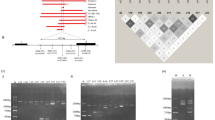Abstract
We tested applicability of a new genotyping technique to detect a low abundance CD17 (A → T) mutation of β-globin gene. The technique utilized a combined gap ligase chain reaction (Gap-LCR) and quantitative PCR (qPCR) methods. One pair of Gap-LCR primers was modified by adding specific sequences to the 5′ end of the upstream and the 3′ end of the downstream primer which served as a combining sequence for qPCR. First, specific mutation is detected using Gap-LCR; then, ligation products are detected by qPCR. Our results show that the amount of LCR products is directly proportional to the amount of template DNA. We further demonstrate that this technique detects a low abundance mutant DNA with a mutant/normal allele ratio as low as 1:10000. This technique was applied to detect a paternally inherited CD17 mutation from 53 maternal plasma samples. The results were consistent with those obtained by PCR/reverse dot blot of amniotic fluid cell DNA. In conclusion, by combining Gap-LCR and qPCR technology we successfully established a highly sensitive technique to detect low abundance point mutations. This technique can be applied to detect fetal DNA point mutation in maternal plasma.

Similar content being viewed by others
References
Chiu, R. W., & Lo, Y. M. (2011). Non-invasive prenatal diagnosis by fetal nucleic acid analysis in maternal plasma: the coming of age. Seminars in Fetal and Neonatal Medicine, 16, 88–93.
Ding, C., Chiu, R. W., Lau, T. K., Leung, T. N., Chan, L. C., Chan, A. Y., et al. (2004). MS analysis of single-nucleotide differences in circulating nucleic acids: Application to noninvasive prenatal diagnosis. Proceedings of the National Academy of Sciences of the United States of America, 101, 10762–10767.
Wu, D. Y., & Wallace, R. B. (1989). The ligation amplification reaction (LAR)—amplification of specific DNA sequences using sequential rounds of template-dependent ligation. Genomics, 4, 560–569.
Benjamin, W. H, Jr., Smith, K. R., & Waites, K. B. (2003). Ligase chain reaction. Methods in Molecular Biology, 226, 135–150.
Winn-Deen, E. S., Batt, C. A., & Wiedmann, M. (1993). Non-radioactive detection of Mycobacterium tuberculosis LCR products in a microtitre plate format. Molecular and Cellular Probes, 7, 179–186.
Iovannisci, D. M., & Winn-Deen, E. S. (1993). Ligation amplification and fluorescence detection of Mycobacterium tuberculosis DNA. Molecular and Cellular Probes, 7, 35–43.
Abravaya, K., Carrino, J. J., Muldoon, S., & Lee, H. H. (1995). Detection of point mutations with a modified ligase chain reaction (Gap-LCR). Nucleic Acids Research, 23, 675–682.
Yu, H., Merchant, B., Scheffel, C., Yandava, C., Drazen, J. M., & Huff, J. (2001). Automated detection of single nucleotide polymorphism in beta-2 adrenergic receptor gene using LCx(R). Clinica Chimica Acta, 308, 17–24.
Leon, M. E., Perez Del Molino, M. L., Lado Lado, F. L., Pazo, N. M., & Pardo, F. (2004). Use of ligase chain reaction for the rapid diagnosis of lymph node tuberculosis. Scandinavian Journal of Infectious Diseases, 36, 724–726.
Ribeiro, F. K., Dettoni, V. V., Peres, R. L., Vinhas, S. A., Co, T. R., Dietze R., et al. (2004) Evaluation of a commercial test based on ligase chain reaction for direct detection of Mycobacterium tuberculosis in respiratory specimens. Revista da Sociedade Brasileira de Medicina Tropical, 37, 431–435.
Harden, S. V., Thomas, D. C., Benoit, N., Minhas, K., Westra, W. H., Califano, J. A., et al. (2004). Real-time gap ligase chain reaction: a rapid semiquantitative assay for detecting p53 mutation at low levels in surgical margins and lymph nodes from resected lung and head and neck tumors. Clinical Cancer Research, 10, 2379–2385.
Masasyesva, B. G., Tong, B. C., Brock, M. V., Pilkington, T., Goldenberg, D., Sidransky, D., et al. (2005). Molecular margin analysis predicts local recurrence after sublobar resection of lung cancer. International Journal of Cancer, 113, 1022–1025.
Lo, Y. M., Tein, M. S., Lau, T. K., Haines, C. J., Leung, T. N., Poon, P. M., et al. (1998). Quantitative analysis of fetal DNA in maternal plasma and serum: implications for noninvasive prenatal diagnosis. American Journal of Human Genetics, 62, 768–775.
Lo, Y. M. (2003). Fetal DNA in maternal plasma/serum: the first 5 years. Pediatric Research, 53, 16–17.
Wataganara, T., & Bianchi, D. W. (2004). Fetal cell-free nucleic acids in the maternal circulation: new clinical applications. Annals of the New York Academy of Sciences, 1022, 90–99.
Chiu, R. W., & Lo, Y. M. (2004). Recent developments in fetal DNA in maternal plasma. Annals of the New York Academy of Sciences, 1022, 100–104.
Acknowledgments
The authors acknowledge Bing Deng (Diagnostic Centre of Molecular Biology, the Affiliated Children’s Hospital, Chongqing Medical University) for kindly providing DNA samples. This study was supported by the National Natural Science Foundation of China (No. 30801247) and by the National Key Technology R&D Program (No. 2006BA105A05).
Author information
Authors and Affiliations
Corresponding author
Additional information
P. Yi and H. Jiang contributed equally to this work.
Rights and permissions
About this article
Cite this article
Yi, P., Jiang, H., Li, L. et al. A New Genotyping Method for Detecting Low Abundance Single Nucleotide Mutations Based on Gap Ligase Chain Reaction and Quantitative PCR Assay. Cell Biochem Biophys 62, 161–167 (2012). https://doi.org/10.1007/s12013-011-9277-2
Published:
Issue Date:
DOI: https://doi.org/10.1007/s12013-011-9277-2




